Fond mobile flottant & économiseur d’énergie
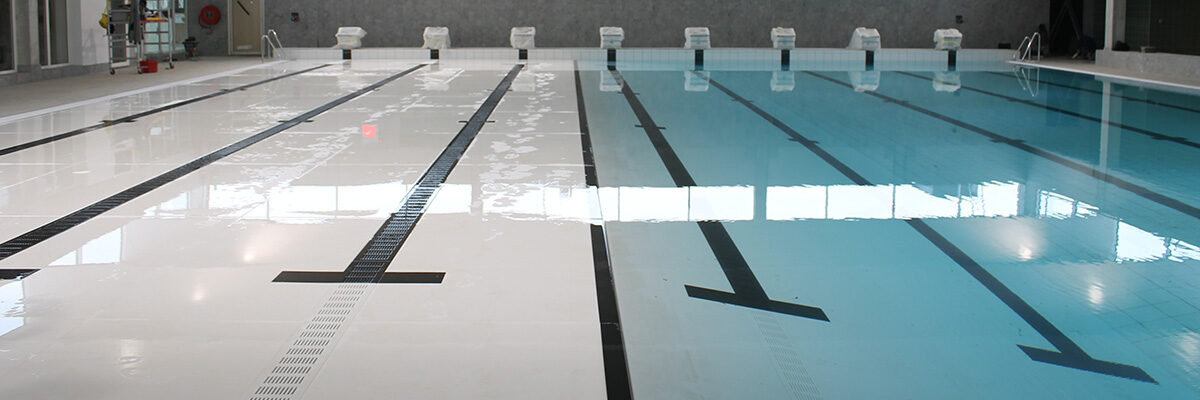
Les piscines sont un espace de loisirs prisé, que ce soit pour se reposer ou pour se maintenir en forme. Malheureusement elles sont également quelque peu consommatrices d’énergie à proprement parler. Un des moyens d’effectuer des économies d’énergie est possible lorsque l’on installe un fond mobile. Comment peut-il contribuer à économiser de l’énergie ? D’un point de vue relatif à son aspect purement fonctionnel, un fond mobile est un équipement qui permet l’utilisation d’un bassin de piscine à différentes profondeurs ce qui favorise, d’une part, l’optimisation d’occupation de l’espace en eau ainsi que la sécurisation des enfants & des non-nageurs & d’autre part, une économie d’énergie.
Il existe essentiellement 2 systèmes de fonctionnement pour ce type d’équipement. Le premier consiste en l’élévation par poussée ou l’abaissement par traction du fond mobile dans un bassin en eau à l’aide d’un moteur électrique qui coordonne un système de broches ou de ciseaux. Le second permet d’être + économique grâce à la mise en œuvre d’un fond mobile flottant qu’il suffit de tirer vers le bas pour le changer de position. Cette action est possible grâce à des vérins hydrauliques qui tirent sur des câbles ; ce système écarte la nécessité d’utiliser des composants électriques ou électromécaniques dans ou près de l’eau. Le grand avantage d’un fond mobile est également sa stabilité (160 kilos par mètre carré) car il est soutenu par des blocs flottants qui sont uniformément répartis sous la surface totale du plancher ; en outre, cette configuration autorise une surface plane avec une grande portée dans les plus grandes piscines.
Un fond mobile flottant représente la plus grande valeur d’isolation et permet d’économiser de l’énergie en empêchant l’eau de refroidir trop vite. Lorsqu’il est positionné à ras des bords de la piscine, non seulement il isole mais il diminue également l’évaporation des produits chimiques utilisés pour traiter l’eau. Une économie financière qui se défend grâce à la capacité d’isolation élevée du matériau utilisé. Un exemple de plancher mobile auto-flottant et isolant est le plancher de Variopool.
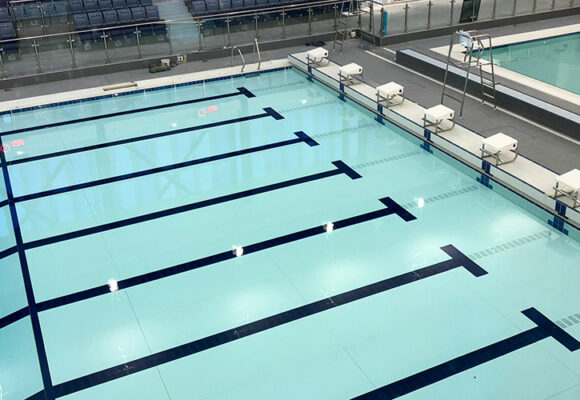
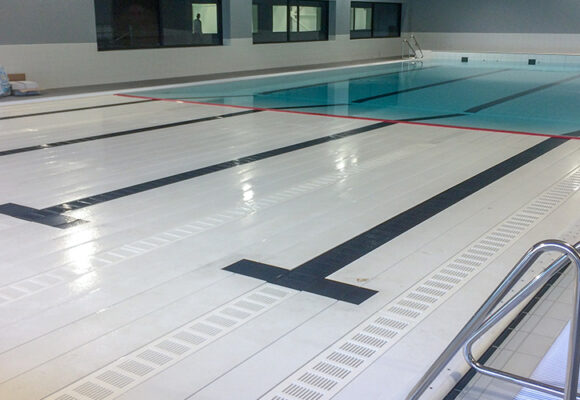
Flottabilité d’un plancher mobile
Un fond mobile a une capacité isolante élevée car il est composé de blocs de flottaison en matériau isolant tel que le polystyrène et d’un revêtement en plaques de polypropylène. Ces composants ont une très bonne capacité isolante. Les associer permet un dédoublement de la dire-capacité. Par ailleurs, lorsque le fond mobile est positionné à sa hauteur maximale, l’air présent dans l’espace entre le fond mobile et l’eau du bassin est également considéré tel un isolateur supplémentaire. Quant au joint périphérique en caoutchouc qui entoure le fond mobile représente, il est lui aussi une barrière isolante entre les parois de la piscine et le bord du fond mobile. Tout comme pour une fenêtre, avec ou sans joint (de vitrage), la différence de qualité d’isolation est énorme.
Les matériaux, utilisés dans la conception de notre fond mobile et énoncés ci-dessus, sont utiles pour retenir la chaleur afin de conserver la température de l’eau mais aussi afin d’empêcher l’évaporation des produits chimiques de traitement de l’eau. Ceci sous-entend que, grâce au fond mobile, le chauffe-eau fonctionne moins souvent, moins longtemps et que, moins de produits de traitement de l’eau sont nécessaires pour en garantir une bonne qualité. Des études stipulent qu’une économie est ainsi réalisable à hauteur de 30% sur les factures d’énergie et à hauteur de 25% sur la consommation de produits chimiques. Une analyse de rentabilité révèle un amortissement de l’investissement d’un fond mobile en moins de 10 ans.
En partant du principe qu’un fond mobile, régulièrement entretenu, a une durée de vie d’environ 25 ans, il apparaît clairement que, grâce à son installation dans un bassin, de nombreuses dépenses sont limitées, que des économies d’énergie sont notoires et qu’une protection de l’environnement est respectée. Une économie plurielle favorisant une attention particulière à porter à ce produit.
Lorsque la piscine n’accueille pas de public, on peut recouvrir la bassin à l’aide du fond mobile. Positionné à fleur avec le parterre de la piscine, il empêche les personnes de tomber à l’eau et, au pire, de se noyer. Les couvertures classiques de piscine, empêchent certes une certaine déperdition de chaleur et l’évaporation de l’eau mais elles ne peuvent pas supporter le poids d’un animal ou d’une personne. Si, par malheur, quelqu’un devait accidentellement tomber à l’eau, le risque serait qu’il reste coincé sous la couverture. Nous connaissons tous des exemples exposant les dangers de ce type de chute dans un bassin.
En utilisant un fond mobile en guise de couverture thermique en lieu et place d’une couverture classique, tous ces désagréments peuvent être évités tout en profitant d’une bien meilleure capacité d’isolation.
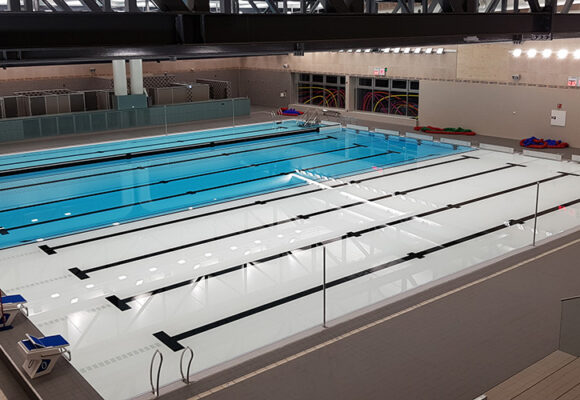
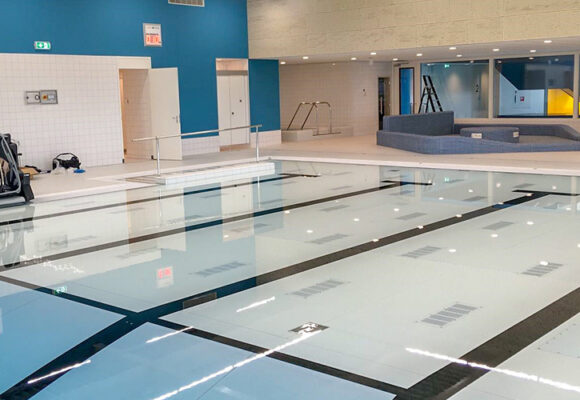
Durabilité et rentabilité du fond mobile
Un autre avantage important du fond mobile est qu’il permet d’agrandir la surface exploitable de la piscine, de s’adapter à différents besoins de nageurs de catégories différentes, ou encore, de diminuer la quantité d’eau de la piscine nécessaire selon les activités. Le besoin de moins d’eau signifie qu’il est nécessaire de moins d’énergie pour chauffer l’eau ; par ailleurs, la piscine peut être couverte lorsqu’elle n’est pas utilisée, ce qui empêche l’évaporation de l’eau, préserve sa température et maintient une bonne qualité d’eau avec bien moins de produits chimiques.
Un fond mobile dans un bassin extérieur peut même être utilisé pour chauffer l’eau, ceci grâce à l’énergie solaire. En soulevant le fond lorsque le soleil brille, l’eau peut être chauffée par le rayonnement solaire.
Cependant, les avantages d’un fond mobile sont bien plus nombreux. Vu qu’il permet d’optimiser la surface utile d’un bassin en eau, cet équipement permet de réduire la taille des établissements aquatiques. Cette réduction se traduit par des coûts de constructions diminués, par un impact important sur le coût énergétique total et l’empreinte écologique du bâtiment lui-même. Par ailleurs, une maintenance préventive annuelle peut également présenter un réel avantage pour l’exploitant de piscine ou pour l’opérateur économique. Il convient de préciser que toutes économies effectuées impactent favorablement tous les utilisateurs de la piscine.
En nous basant sur notre expérience, nous constatons qu’un fond mobile bien entretenu a une durée de vie moyenne allant de 25 à 30 ans. Il n’est pas rare que d’autres systèmes (avec seulement 10 voire maximum 15 années d’utilisation) soient remplacés par notre système de fond mobile flottant. Comme il n’y a pas de composants électriques ou électromécaniques à l’intérieur de la piscine, et qu’il n’est pas nécessaire d’utiliser de composant chimique supplémentaire pour faire fonctionner le système de plancher, l’usure de notre système de fond mobile à flottaison est plutôt limitée. En somme, sa longue durée de vie contribue positivement à l’empreinte écologique totale et au modèle économique. Il existe bel et bien un ensemble de facteurs en faveur de l’économie d’énergie et de limitation de certains frais d’exploitation.
Retour sur investissement
Un plancher de piscine mobile offre de nombreux avantages, notamment une plus grande flexibilité, une sécurité améliorée et des économies d’énergie. En optimisant les capacités d’exploitation de l’espace du centre aquatique, en utilisant de l’énergie solaire et en permettant d’économiser de l’énergie grâce aux matériaux d’isolation le composant, un plancher mobile de piscine contribue fortement à une piscine plus durable. Le retour sur investissement d’un plancher de piscine mobile est énorme.
Tout en économisant certains coûts de construction, la consommation d’énergie et quelques frais de fonctionnement pendant toute la durée de vie technique et en créant plus de flexibilité pour accueillir différents groupes cibles, un plancher mobile permet d’économiser de nombreuses dépenses et permet d’augmenter les revenus. Et tout cela moyennant une faible empreinte carbone.
Installer un plancher mobile, ce n’est pas seulement acheter un produit technique ; c’est aussi proposer aux usagers des activités pour un bien-être physique et psychologique grâce à une technologie de pointe moyennant une faible empreinte écologique et la possibilité de réaliser des économies notoires pendant la construction mais aussi pendant toutes les années d’exploitation.